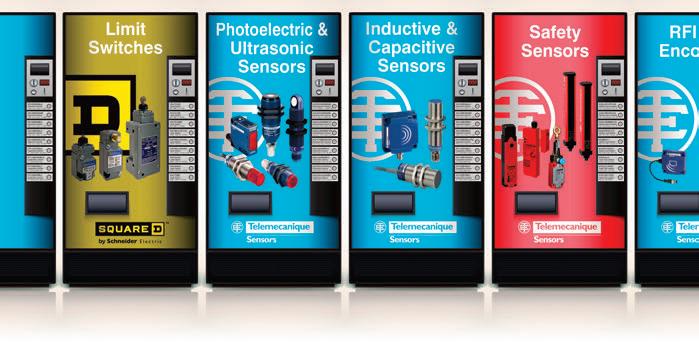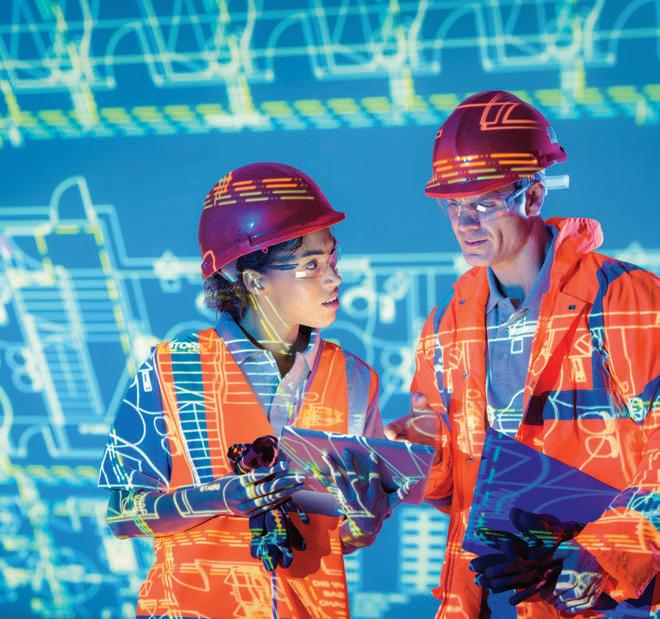
7 minute read
Selecting Process Sensors
While all sensors deliver basic data about operations, process sensors have such varied applications that the selection process surrounding their purchase deserves additional consideration.
This article highlights the key decision factors to be considered with several dierent types of process sensors, including infrared and contact sensors, temperature sensors, level sensors, flow sensors, and pressure sensors.
TEMPERATURE SENSORS The level of stability needed for temperature measurement often comes down to a balance of reliability, process eciency, and risk management. All sensors drift over time, no matter the type, but resistance temperature detectors (RTDs) prove to be more stable and linear in the way they drift than thermocouples. Traditionally, thermocouples oered the fastest rate of response and most rugged construction. In some applications, this could outweigh the reliability of RTDs. However, as RTD technology improves, it is possible to realize thermocouple response times and increased vibration resistance, as well as better long-term stability for temperature measurement.
Frequency of calibration for a temperature measurement is typically determined by balancing risk and expense. More frequent calibrations reduce risk by increasing the safety of product and/or personnel. However, it also increases cost and downtime. Similarly, less frequent calibrations will improve eciency and productivity, but add risk to the process.
When it comes to choosing between infrared and contact temperature sensors, the choice typically comes down to application and installation limitations, as both fulfill dierent industry and customer requirements.
Infrared sensors are more suited for open vessel, surface, or area temperature measurement, such as installations with rotating or moving assemblies. They are also suitable for applications that have extreme high temperature requirements where the sensor and electronics must be mounted remotely from the measurement point and contact is not possible. These high temperature applications typically exceed 1600° C. Environmental factors, such as moisture, dust, dirt may obstruct infrared sensor measurement and lead to inaccuracies or increased maintenance.
High process temperature applications such as incinerators, fluidized bed furnaces and glass or porcelain production that operate at temperatures below 1600° C can be addressed with thermocouples and ceramic thermowells. Ceramic thermowells oer durability for aggressive installations, and have high accuracy, long-term reliability, and are simple to maintain.
For more standard temperature sensing applications (e.g., fluids heated to less than 600° C), contacting RTD and thermocouple measurements are an efficient, robust, and simple temperature solution. Typically, contacting temperature assembly selection is tied to industry-specific demands, approvals, designs, and certifications to fit each industry. Using thermowells to fit these requirements also allows for temperature sensors to be removed from the process for calibration or service without shutting down the line. There are special thermowells designed for tool-free removal of the temperature sensor from the thermowell, which is very useful in installations requiring frequent calibrations.
LEVEL SENSORS When trying to determine the best level device to use for an application, the first question to understand and honestly answer is: “What is the goal of the measurement?” Examples of goals beyond the basic need for a level sensor could include: • The process keeps overfilling. A sensor is needed to help prevent the overfill from occurring to provide a safer work environment for operators and improve production yield. In addition, this helps avoid regulatory fines which are expensive and take time to report. • The plant has run out of raw materials twice this year and causing major upsets to the supply chain, meeting customer orders, and overall profitability. A sensor is needed to help reliably monitor raw material inventories to ensure the plant can keep running.
Once the goal of the measurement is clearly understood, one can look to evaluate other factors that contribute to finding the best measurement device for the application. Key things to evaluate here include: • Mechanical installation options; • Process media; and • Process conditions (i.e., pressure, temperature, foam, etc.)
By first understanding the goal of the level measurement and accounting for mechanical and process conditions, choosing the best sensor is simplified.
FLOW SENSORS When assessing dierent flow sensors, the first question that should be asked is what sort of data can the flow sensor provide? In today’s world, instrumentation is no longer seen as just an instrument, but rather a true process analyzer. For example, a Coriolis flowmeter can provide mass flow, volume flow, density, temperature, viscosity, and even a concentration measurement such as API degrees, proof/volume, and Brix degrees. Vortex and ultrasonic flowmeters can provide mass flow, temperature, pressure, and even energy values of the gas they’re measuring.
The second question should focus on the export of data out of the sensor. Digital communications such as EtherNet/IP and Profinet are becoming more popular with the demand for digitally connected devices. These digital communications allow you to transmit all the variables mentioned above plus advanced diagnostics and monitoring functionality. The ability to combine these digital communications with standard analog 4-20 mA or pulse outputs provides complete functionality for any application. For those applications where digital communications are
not feasible, there are other options, such as OPC-UA connectivity on devices to support customers who want to get device information simply and directly to a cloud.
The third question you should ask is: How do I know my flowmeter is healthy? Most flowmeters today incorporate an onboard verification that can be run on demand to test the entire signal chain of the device, from sensor to transmitter. Some of these onboard verifications include a report that can be directly exported from the device via the control system via digital communications. Best-in-class verifications are traceable to known metrology standards, which adds confidence to the quality of the verification methodology.
PRESSURE SENSORS The selection of a pressure transmitter is very application dependent. That is why you typically find so many options available. Ultimately the choice is going to be based upon one or more of these basic values: simplicity, safety, and process eciency.
Direct-reading metal sensors are the type of sensor most end users think of when speaking about pressure transmitters. These sensors are comprised of a single diaphragm welded to the process connection separating the fill fluid and sensor chip from the process medium. Any change in process pressure is directly transferred via the non-compressible fill fluid to the sensor chip. With a limited variety of diaphragm materials and fill fluids available, direct-reading metal sensors are employed in non-aggressive process fluids with temperatures <260° F. This makes the direct-reading metal sensor simple to install, commission, and reliable for many applications.
Direct-reading ceramic sensors dier from direct reading metal sensors in that the process contact material ceramic and they do not have fill fluid. These sensors are a completely dry cell. The ceramic cell in these sensors means that they are less susceptible to ambient temperature shock, they’re immune to hydrogen permeation issues, and can be employed in even the deepest vacuum application. Ceramic has a maximum process temperature capability of 300° F and is extremely durable. Durability is important for slurries and other abrasive mediums or viscous fluids that tend to build up and require high pressure or mechanical cleaning.
Cleaning a metal sensor is never recommended, as it is too easily damaged, which will impact your measurement accuracy
ONE source. Unlimited sensor options.

Simply easy!
AUTOMATION AUTOMATION EVENT, THEATER VENT THEAT & LIGHTING
CHEMICAL HEMICA
MATERIAL TERIAL HANDLING FOOD AND BEVERAGE OD AND BEVERA
ROBOTICS ROBOTICS
TRAYCONTROLo 550 TPE
TRAYCONTROLo 550 TPE is a flexible, oil-resistant control and power cable. The special combination of TC-ER, PLTC-ER and ITC-ER allows this cable to be used as a connecting cable for AC, DC or control wiring in accordance with NFPA 79. this cable is approved for open, unprotected installation in cable trays to the machine. Its outstanding oil resistance (Oil Res I/II) guarantees a long service life for industrial applications in dry, damp and wet environments. When it comes to choosing between infrared and contact temperature sensors, the choice comes down to application and installation limitations, as both fulfill different industry and customer requirements.
and longevity. Ceramic cells, however, can be cleaned using a wire brush without fear of damaging the sensor. Ceramic cells also provide broken membrane detection. On the off chance the ceramic membrane becomes cracked or damaged, the transmitter will immediately alert the control system. With ceramic sensors, you maintain the simplicity of a metal sensor with the added process safety of broken membrane detection and reduced maintenance thanks to the robust nature of ceramic.
Remote diaphragm seals sensors are often used in corrosive and/or high temperature applications. A remote diaphragm seal is a secondary diaphragm with an oil-filled channel or capillary relaying process pressure back to a measurement cell consisting of a direct reading metal sensor.
Process temperatures greater than 260° F typically require the use of a remote diaphragm seal, as there is too much risk that conductive or radiant heat will damage the sensitive electronics of the measurement cell. This is especially true if ambient temperature levels are also high. Remote diaphragm seals coated with materials such as Monel, tantalum or gold have added protection from corrosive process mediums and provide greater safety for the process, property, and personnel.






